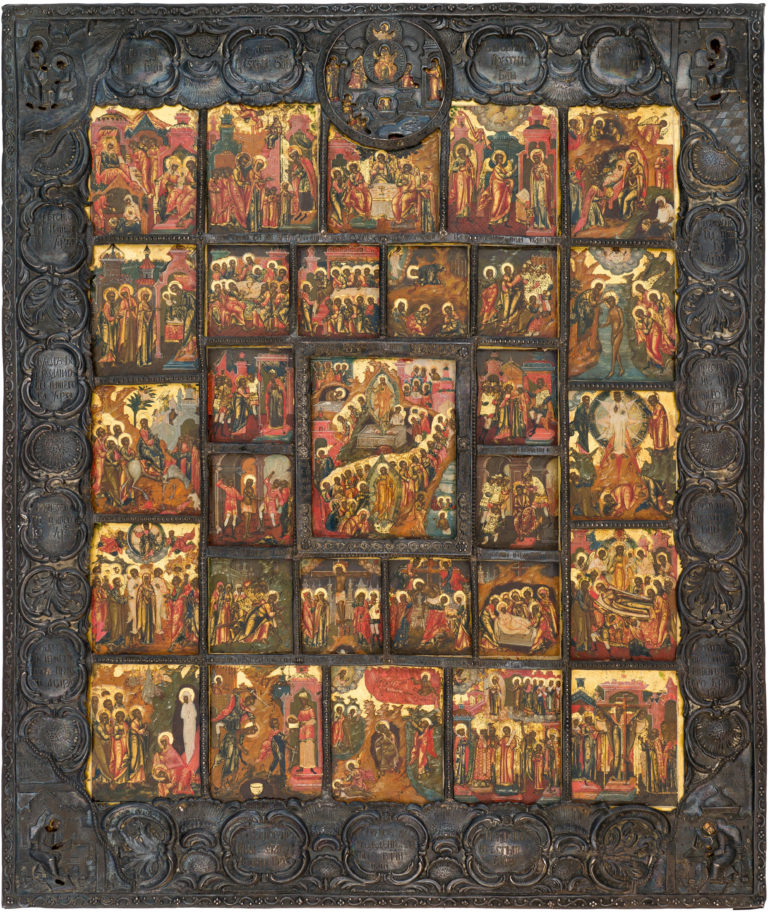The Resurrection—the Descent into Hell, with Images of the Evangelists, the Monogenes, the Passions of Christ, and the Church Feasts in 28 Border Scenes
Icon: second quarter of the 19th century. Palekh.
Oklad cover: 1846. St. Petersburg. Master I.F. Chekalin (?)
Size: 45 х 37 х 2,8 cm
Wood (three panels), two support boards (now lost), absence of incut centerpiece, underlying layer of canvas, tempera, gold. Oklad cover: silver, embossing, engraving, light etching.
Brands on the Oklad cover: St. Petersburg coat-of-arms (1818–1864); silver hallmark «84»; «Д·Т / 1846» – assayer’s brand (assayer Dmitii Ivanovich Tverskoy; 1832–1850); the lettering «[И].Ф.» in the rectangular shield is, most likely, the name brand of the silversmith Ignatii Fedorovich Chekalin (1825–1855).
The author’s paintwork is in fairly good condition. In some places, there are small fragments of restoration toning over initial losses of gesso and original paint. Restoration is especially evident on the borders; the figures of the Evangelists Luke and Mathew have been thoroughly repainted.
Contact us

The Resurrection—the Descent into Hell, with Images of the Evangelists, the Monogenes, the Passions of Christ, and the Church Feasts in 28 Border Scenes
Diagram of the border scenes:
The Festive cycle:
- The Nativity of the Mother of God;
- The Entrance of the Mother of God into the Temple;
- The Old Testament Trinity;
- The Annunciation;
- The Nativity of Christ;
- Candlemas (The Meeting of Christ in the Temple);
- The Theophany (The Baptism of Christ);
- The Entrance into Jerusalem;
- The Transfiguration;
- The Ascension of Christ;
- The Dormition of the Mother of God;
- The Raising of Lazarus;
- The Beheading of John the Baptist;
- The Fiery Ascent of the Prophet Elijah;
- The Pokrov (Feast of the Protective Veil of the Mother of God);
- The Elevation of the Holy Cross.
DiThe Passion Cycle:
- The Last Supper;
- The Washing of the Feet;
- The Prayer in Gethsemane;
- The Betrayal of Judas;
- The Bringing of Christ to Caiaphas;
- The Bringing of Christ before Pilate;
- The Flagellation of Christ;
- The Crown of Thorns;
- The Carrying of the Cross;
- The Crucifixion;
- The Taking Down from the Cross;
- The Entombment of Christ.
- The Monogenes (The Only Begotten Son);
- The Evangelist John;
- The Evangelist Matthew;
- The Evangelist Mark;
- The Evangelist Luke.
Hand-painted Orthodox icons with scenes of the Resurrection – the Harrowing the Hades and other Church Feasts, reflecting the major events of the liturgical year, became widespread in the 19th century, predominantly in the works of Palekh artists who were heavily influenced by the 17th century traditions. The given Russian icon is one of these famous religious icons.
The centerpiece of this antique icon bears the simplified iconographic scheme of the Resurrection that appeared in the 17th century. Scenes of the “Rising from the Tomb” and “The Harrowing of Hades” are depicted along a single vertical line and are compositionally bound together by the diagonal procession of the Pious marching into Heaven. This composition is surrounded by scenes that came before or followed the Resurrection. The top left corner bears the image of the Incredulity of Thomas and the Apostle Peter at the Empty Tomb; on the right – the Revelation of Christ to the Apostles on the Sea of Galilee.
The centerpiece is surrounded by two cycles of border scenes. The inner cycle consists of twelve Passion scenes. The outer one is a Festive cycle with fifteen scenes, starting with the Nativity of the Mother of God, which begins the liturgical year, and ending with the Elevation of the Holy Cross.
This Russian icon is one of highly-recognizable examples of Palekh religious icon art; it clearly yearns towards the masterpieces of the late 18th – early 19th centuries and is noteworthy for its high level of artistry. Among the characteristic traits of the given antique icon is the miniature painting with the most thorough execution of the faces and lesser details, the elegant proportions of the elongated figures, and the brilliantly clear composition. Nevertheless, the overt complication of the details, the ‘polished up’ and seeming dryness of the painting, and the vestment’s gold overlay all indicate that this Orthodox icon was painted in a later period, more precisely – in the second quarter of the 19th century.
The precious oklad cover was made in 1846 in St. Petersburg by the silversmith Ignatii Fedorovich Chekalin (many of his works are known, ranging from 1825 to 1855). It is a wonderful example of the so-called Second Baroque style – a movement which won popularity and prominence in the second quarter of the 19th century.